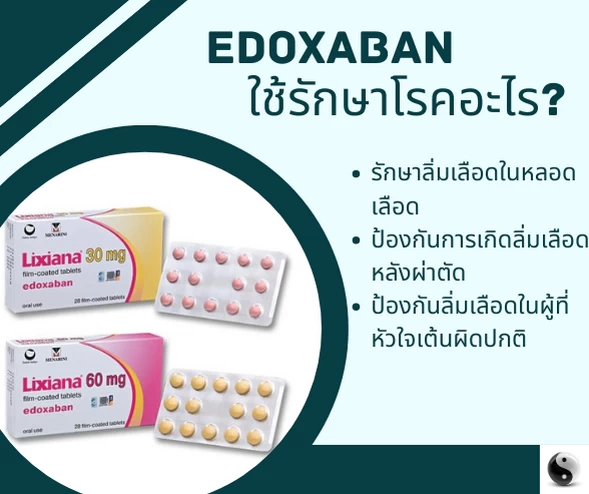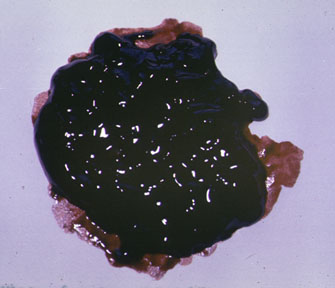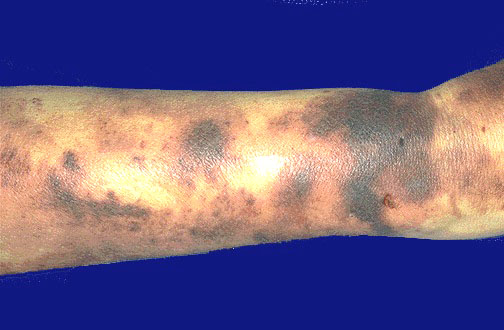Edoxaban: คู่มือการใช้ยาอย่างปลอดภัยและข้อมูลสำคัญสำหรับการป้องกันและรักษาลิ่มเลือด
วันที่เผยแพร่: 27 กรกฎาคม 2568, 23:00 น. ผู้เขียน: นายแพทย์ ประพันธ์ ปลื้มภาณุภัทร, อายุรแพทย์, แพทย์เวชศาสตร์ครอบครัว ที่มา: SiamHealth.net
บทความนี้จะให้ข้อมูลที่ครบถ้วนและสำคัญเกี่ยวกับยา Edoxaban ซึ่งเป็นยาต้านการแข็งตัวของเลือดชนิดใหม่ (Novel Oral Anticoagulant - NOAC) ที่ใช้กันอย่างแพร่หลาย จุดประสงค์หลักคือเพื่อให้ผู้ป่วยและบุคคลทั่วไปมีความรู้ความเข้าใจที่ถูกต้องเกี่ยวกับยานี้ สามารถใช้ยาได้อย่างปลอดภัย และทราบถึงข้อควรระวังต่างๆ ที่สำคัญ การมีความรู้เกี่ยวกับยาที่คุณใช้จะช่วยให้คุณจัดการกับโรคและป้องกันภาวะแทรกซ้อนได้อย่างมีประสิทธิภาพ และมีคุณภาพชีวิตที่ดีขึ้น
1. Edoxaban คืออะไร?
Edoxaban (อีดอกซาแบน) เป็นยาในกลุ่ม Novel Oral Anticoagulants (NOACs) หรือ Direct Oral Anticoagulants (DOACs) ประเภท Factor Xa Inhibitor เช่นเดียวกับ Apixaban และ Rivaroxaban ยานี้ออกฤทธิ์โดยการยับยั้งปัจจัยการแข็งตัวของเลือดที่สำคัญตัวหนึ่งคือ Factor Xa (Factor Ten A) ทำให้กระบวนการแข็งตัวของเลือดช้าลง และลดความเสี่ยงในการเกิดลิ่มเลือดอันตราย ชื่อทางการค้าที่เป็นที่รู้จักกันดีคือ Lixiana (ลิเซียน่า) Edoxaban เป็นยารับประทานที่ออกฤทธิ์รวดเร็วและคาดการณ์ได้ ทำให้สะดวกในการใช้งาน ไม่จำเป็นต้องมีการตรวจเลือดเพื่อปรับขนาดยาบ่อยครั้งเหมือนยาละลายลิ่มเลือดชนิดเก่าอย่าง Warfarin ในประเทศไทย Edoxaban เป็นยาที่ต้องใช้ตามใบสั่งแพทย์เท่านั้น
2. กลไกการออกฤทธิ์: Edoxaban ทำงานอย่างไร?
กระบวนการแข็งตัวของเลือดเป็นสิ่งจำเป็นในการหยุดเลือดเมื่อเกิดบาดแผล แต่การก่อตัวของลิ่มเลือดที่ผิดปกติในหลอดเลือดอาจนำไปสู่ปัญหาสุขภาพที่รุนแรงได้ Edoxaban ออกฤทธิ์โดย:
-
ยับยั้ง Factor Xa โดยตรง: Edoxaban เป็นยาที่ออกฤทธิ์ยับยั้ง Factor Xa ซึ่งเป็นโปรตีนสำคัญในเส้นทางการแข็งตัวของเลือด Factor Xa มีบทบาทในการเปลี่ยน Prothrombin ไปเป็น Thrombin ซึ่งเป็นเอนไซม์สำคัญที่ทำให้เกิดลิ่มเลือด
-
ลดการสร้าง Thrombin: เมื่อ Factor Xa ถูกยับยั้ง การสร้าง Thrombin ก็จะลดลงอย่างมีนัยสำคัญ
-
ป้องกันการเกิดลิ่มเลือด: การลดการสร้าง Thrombin ทำให้เลือดแข็งตัวได้ยากขึ้น จึงช่วยป้องกันการก่อตัวของลิ่มเลือดที่ผิดปกติ หรือช่วยรักษาภาวะลิ่มเลือดที่เป็นอยู่แล้ว
กลไกนี้ทำให้ Edoxaban มีฤทธิ์ต้านการแข็งตัวของเลือดที่คาดการณ์ได้ ไม่จำเป็นต้องมีการตรวจเลือดเพื่อปรับขนาดยาบ่อยครั้งเหมือน Warfarin และมีปฏิกิริยากับอาหารน้อยกว่า
3. Edoxaban ใช้รักษาโรคอะไร?
Edoxaban ใช้สำหรับป้องกันและรักษาภาวะลิ่มเลือดอุดตันในหลายกรณี:
-
ป้องกันโรคหลอดเลือดสมองและลิ่มเลือดอุดตันในร่างกาย (Systemic Embolism):
-
รักษาภาวะลิ่มเลือดอุดตันในหลอดเลือดดำ (Deep Vein Thrombosis - DVT):
-
ป้องกันภาวะลิ่มเลือดอุดตันซ้ำ: หลังจากที่ได้รับการรักษา DVT หรือ PE ครั้งแรกแล้ว
ข้อสำคัญ: Edoxaban ไม่ควรใช้ในผู้ป่วยที่มีภาวะหัวใจเต้นผิดจังหวะ AF ที่เกิดจากลิ้นหัวใจตีบปานกลางถึงรุนแรง หรือผู้ที่ได้รับการใส่ลิ้นหัวใจเทียม
4. ขนาดและวิธีการใช้ยา
Edoxaban มีจำหน่ายในรูปแบบยาเม็ดสำหรับรับประทาน โดยมีขนาด 15 มิลลิกรัม (mg), 30 มิลลิกรัม (mg), และ 60 มิลลิกรัม (mg)
ขนาดยาที่ใช้แตกต่างกันไปตามข้อบ่งใช้:
วิธีการใช้ยา:
-
รับประทานยาพร้อมอาหารหรือไม่พร้อมอาหารก็ได้:
-
กลืนยาเม็ดทั้งเม็ดพร้อมน้ำ:
-
รับประทานยาในเวลาเดียวกันทุกวัน: เพื่อรักษาระดับยาในร่างกายให้คงที่และมีประสิทธิภาพในการป้องกันลิ่มเลือด
หมายเหตุ: แพทย์จะเป็นผู้กำหนดขนาดยาและระยะเวลาการรักษาที่เหมาะสมสำหรับผู้ป่วยแต่ละราย ห้ามปรับขนาดยาเองเด็ดขาด
5. สิ่งที่ต้องแจ้งแพทย์หรือเภสัชกรก่อนใช้ยา
การแจ้งข้อมูลสุขภาพของคุณอย่างครบถ้วนเป็นสิ่งสำคัญอย่างยิ่ง เพื่อความปลอดภัยในการใช้ Edoxaban คุณควรแจ้งแพทย์หรือเภสัชกรเกี่ยวกับ:
-
ประวัติการแพ้ยา: เคยแพ้ยา Edoxaban หรือส่วนประกอบใดๆ ในยา หรือยาละลายลิ่มเลือดชนิดอื่นหรือไม่
-
ประวัติการมีเลือดออกผิดปกติหรือมีภาวะเลือดออกง่าย: เช่น เลือดออกในสมอง, เลือดออกในทางเดินอาหาร, แผลในกระเพาะอาหาร, หรือภาวะเลือดออกที่ควบคุมไม่ได้
-
โรคประจำตัวอื่นๆ: โดยเฉพาะโรคตับ (ปานกลางถึงรุนแรง), โรคไต (ไตวายรุนแรง หรือกำลังฟอกไต), หรือมีเลือดออกที่ควบคุมไม่ได้
-
การตั้งครรภ์ หรือกำลังวางแผนตั้งครรภ์: โดยทั่วไปไม่แนะนำให้ใช้ Edoxaban ในหญิงตั้งครรภ์
-
การให้นมบุตร: ยาอาจผ่านเข้าสู่น้ำนมแม่ได้
-
การผ่าตัด หรือหัตถการใดๆ ที่กำลังจะเกิดขึ้น: รวมถึงการทำฟัน การฉีดกระดูกสันหลัง หรือการทำศัลยกรรม
-
ยา วิตามิน อาหารเสริม สมุนไพรอื่นๆ ที่กำลังใช้: รวมถึงยาที่ซื้อเอง หรือยาที่ใช้เป็นครั้งคราว โดยเฉพาะยาที่ส่งผลต่อการแข็งตัวของเลือด (เช่น Aspirin, NSAIDs, Clopidogrel, Warfarin) หรือยาบางชนิดที่ส่งผลต่อเอนไซม์ตับ CYP3A4 และ P-gp (เช่น Rifampicin, Cyclosporine, Erythromycin, Ketoconazole)
6. ข้อควรระวังในการใช้ยา
ควรใช้ Edoxaban ด้วยความระมัดระวังในผู้ป่วยบางราย:
-
ความเสี่ยงของการมีเลือดออก: Edoxaban เพิ่มความเสี่ยงของการมีเลือดออกที่สำคัญและอาจรุนแรงถึงชีวิต โดยเฉพาะในผู้ป่วยสูงอายุ, ผู้ที่มีปัญหาไต (โดยเฉพาะ CrCl น้อยกว่า 15 มล./นาที ไม่แนะนำให้ใช้), ผู้ที่ใช้ยาร่วมกับยาอื่นที่มีผลต่อการแข็งตัวของเลือด, หรือผู้ที่มีประวัติเลือดออกง่าย หากมีอาการเลือดออกผิดปกติ ควรรีบแจ้งแพทย์ทันที
-
ผู้ป่วยที่มีการทำงานของไตบกพร่องรุนแรง (CrCl < 15 ml/min) หรือกำลังฟอกไต: ห้ามใช้ยานี้ เนื่องจากยังไม่มีข้อมูลความปลอดภัยและประสิทธิภาพเพียงพอ และยาอาจสะสมในร่างกาย
-
ผู้ป่วยโรคตับ: โดยเฉพาะผู้ป่วยโรคตับแข็งที่มีความรุนแรงระดับ Child-Pugh class B หรือ C ไม่แนะนำให้ใช้ยานี้
-
ผู้ป่วยที่มีน้ำหนักตัวมาก (Body weight > 120 kg): มีข้อมูลว่ายาอาจมีประสิทธิภาพลดลงในการป้องกันโรคหลอดเลือดสมองในผู้ป่วย AF กลุ่มนี้ ควรปรึกษาแพทย์
-
การหยุดยา Edoxaban อย่างกะทันหัน: อาจเพิ่มความเสี่ยงของการเกิดลิ่มเลือดและโรคหลอดเลือดสมองได้ ควรปรึกษาแพทย์ก่อนหยุดยาเสมอ
-
การทำหัตถการหรือผ่าตัด: ต้องหยุดยา Edoxaban ก่อนการผ่าตัดหรือหัตถการใดๆ ตามคำแนะนำของแพทย์ เพื่อลดความเสี่ยงเลือดออก (ระยะเวลาขึ้นอยู่กับชนิดของหัตถการ)
-
ระวังการเกิดลิ่มเลือดที่ไขสันหลัง (Spinal Hematoma): หากได้รับการฉีดยาเข้าไขสันหลัง หรือทำหัตถการเกี่ยวกับไขสันหลังขณะใช้ยานี้
-
ผู้หญิงที่อยู่ในวัยเจริญพันธุ์: ควรใช้การคุมกำเนิดที่มีประสิทธิภาพขณะใช้ยานี้ เนื่องจากยาอาจส่งผลต่อทารกในครรภ์
7. ระหว่างที่ใช้ยาจะต้องระวังอาการหรือการตรวจพิเศษอะไร?
สิ่งที่ควรพกติดตัวตลอดเวลา:
อาการที่ต้องเฝ้าระวังและควรพบแพทย์ทันที:
-
อาการเลือดออกที่รุนแรงหรือไม่สามารถควบคุมได้:
-
เลือดออกผิดปกติหรือเลือดหยุดยาก เช่น เลือดกำเดาไหลบ่อยและหยุดยาก, เลือดออกตามไรฟันมากผิดปกติ, มีประจำเดือนออกมากและนานผิดปกติ
-
ช้ำง่าย หรือมีจ้ำเลือดตามร่างกายโดยไม่มีสาเหตุ
-
อุจจาระเป็นสีดำคล้ายยางมะตอย หรือมีเลือดสดปนออกมา
-
ปัสสาวะมีสีแดงหรือสีชมพู (มีเลือดปน)
-
อาเจียนเป็นเลือด หรืออาเจียนเป็นสีน้ำตาลคล้ายกากกาแฟ
-
ปวดศีรษะอย่างรุนแรงและเฉียบพลัน, แขนขาอ่อนแรง/ชาครึ่งซีก, พูดไม่ชัด, หรือการมองเห็นเปลี่ยนแปลงไป (อาจบ่งชี้เลือดออกในสมอง)
-
เลือดออกจากการบาดเจ็บที่ไม่หยุดไหล หรือไหลช้าลง
-
อาการแพ้ยาอย่างรุนแรง: เช่น ผื่นลมพิษขึ้นทั่วตัว, บวมที่ใบหน้า ลิ้น หรือคอ, หายใจลำบาก (เป็นภาวะฉุกเฉิน)
การตรวจพิเศษ:
โดยปกติ Edoxaban ไม่จำเป็นต้องมีการตรวจเลือดเพื่อติดตามค่าการแข็งตัวของเลือด (เช่น INR) เป็นประจำเหมือน Warfarin แต่แพทย์อาจมีการตรวจ:
-
การทำงานของไต (Creatinine, CrCl หรือ eGFR): เป็นประจำก่อนเริ่มยาและระหว่างการรักษา โดยเฉพาะในผู้สูงอายุหรือผู้ป่วยที่มีปัญหาไต
-
การทำงานของตับ (Liver Function Tests): หากมีอาการหรือความเสี่ยง
8. ปฏิกิริยาระหว่างยา: ใช้ร่วมกับยาอื่นได้หรือไม่?
Edoxaban สามารถทำปฏิกิริยากับยาอื่นๆ ได้หลายชนิด ซึ่งอาจเพิ่มความเสี่ยงของการมีเลือดออก หรือลดประสิทธิภาพของยา สิ่งสำคัญคือ ต้องแจ้งรายการยา วิตามิน อาหารเสริม สมุนไพรทั้งหมดที่คุณกำลังใช้ให้แพทย์และเภสัชกรทราบเสมอ
ยาที่ต้องระวังเป็นพิเศษ:
9. ผลข้างเคียงหรือไม่พึงประสงค์ของยา
ผลข้างเคียงที่พบบ่อย:
-
เลือดออกง่ายขึ้น: เลือดออกตามไรฟัน, เลือดกำเดาไหล, ช้ำง่าย, มีเลือดออกใต้ผิวหนัง (เป็นผลข้างเคียงที่พบบ่อยที่สุดของยาต้านการแข็งตัวของเลือดทุกชนิด)
-
โลหิตจาง: อ่อนเพลีย, ซีด, เหนื่อยง่าย (จากการเสียเลือดเรื้อรัง)
-
คลื่นไส้
-
ปวดท้อง
ผลข้างเคียงที่พบน้อยแต่รุนแรง:
-
เลือดออกภายในที่รุนแรง: เช่น เลือดออกในสมอง (อาจนำไปสู่ปวดศีรษะรุนแรง, ชัก), เลือดออกในทางเดินอาหาร, เลือดออกในปอด ซึ่งอาจเป็นอันตรายถึงชีวิตได้
-
ปฏิกิริยาการแพ้ยาอย่างรุนแรง: ผื่นลมพิษรุนแรง, บวมที่ใบหน้า/ลิ้น/คอ, หายใจลำบาก (เป็นภาวะฉุกเฉิน)
-
ตับเสียหาย: อาการเช่น ตัวเหลือง, ตาเหลือง, ปัสสาวะสีเข้ม
หากพบอาการรุนแรง หรืออาการที่น่ากังวล ควรรีบหยุดยาและปรึกษาแพทย์ทันที
10. วิธีลดหรือป้องกันผลข้างเคียงของยา
-
รับประทานยาตามขนาดและเวลาที่แพทย์สั่งอย่างเคร่งครัด: ห้ามปรับขนาดยาเองเด็ดขาด
-
ระมัดระวังการทำกิจกรรมที่อาจทำให้เกิดบาดแผลหรือฟกช้ำ: เช่น การโกนหนวดด้วยใบมีด, การใช้แปรงสีฟันแข็ง, การเล่นกีฬาที่มีความเสี่ยงสูง
-
หากมีอาการเลือดออกผิดปกติเล็กน้อย: เช่น เลือดออกตามไรฟัน เลือดกำเดาไหลบ่อย ควรแจ้งแพทย์
-
แจ้งแพทย์ ทันตแพทย์ หรือบุคลากรทางการแพทย์ทุกคน: ว่าคุณกำลังใช้ Edoxaban ก่อนการทำหัตถการใดๆ
-
พกบัตรหรือเอกสารที่ระบุว่าคุณกำลังใช้ยาต้านการแข็งตัวของเลือด: เพื่อแจ้งให้บุคลากรทางการแพทย์ทราบในกรณีฉุกเฉิน
-
หลีกเลี่ยงการใช้ยาอื่นที่เพิ่มความเสี่ยงเลือดออก: เช่น NSAIDs (Ibuprofen), Aspirin, สมุนไพรบางชนิด โดยไม่ปรึกษาแพทย์
-
เข้ารับการตรวจติดตามการทำงานของไตและตับ: ตามนัดหมายของแพทย์
11. หากได้รับยาเกินขนาดต้องทำอย่างไร?
หากรับประทานยา Edoxaban เกินขนาด ความเสี่ยงหลักคือการเกิด เลือดออกที่รุนแรง วิธีแก้ไข: ควรรีบนำผู้ป่วยส่งโรงพยาบาลหรือปรึกษาแพทย์ทันที แม้จะไม่มีอาการเลือดออกก็ตาม แพทย์อาจพิจารณาให้ยาที่ช่วยย้อนฤทธิ์ยาในกลุ่ม Factor Xa Inhibitor (Antidote) เช่น Andexanet alfa (หากมี) หรือให้การรักษาประคับประคองอื่นๆ
12. หากลืมใช้ยาต้องทำอย่างไร?
-
Edoxaban รับประทานวันละ 1 ครั้ง:
-
หากลืมรับประทานยาในมื้อนั้น: ให้รับประทานทันทีที่นึกได้ภายใน 12 ชั่วโมงนับจากเวลาปกติ
-
หากเกิน 12 ชั่วโมงไปแล้ว: ให้ข้ามยาที่ลืมไป และรับประทานยาในมื้อถัดไปตามเวลาปกติ
-
ห้ามรับประทานยาเพิ่มเป็นสองเท่าเพื่อชดเชยยาที่ลืมเด็ดขาด: เพราะอาจทำให้เกิดผลข้างเคียงได้
13. ระยะเวลาการใช้ยา
ระยะเวลาที่คุณจะต้องรับประทาน Edoxaban ขึ้นอยู่กับเหตุผลที่แพทย์สั่งยา:
แพทย์จะเป็นผู้พิจารณาระยะเวลาที่เหมาะสมสำหรับคุณ
14. การเก็บรักษายา
-
เก็บยาที่อุณหภูมิห้อง: ประมาณ 15-30°C (59-86°F) หรือตามที่ระบุบนฉลากยา
-
เก็บในที่แห้งและพ้นจากแสงแดดโดยตรง:
-
เก็บในภาชนะบรรจุเดิมที่ปิดสนิท:
-
เก็บให้พ้นมือเด็กและสัตว์เลี้ยง:
-
ตรวจสอบวันหมดอายุก่อนใช้ยาเสมอ: ห้ามใช้ยาที่หมดอายุแล้ว
15. ความปลอดภัยในสตรีมีครรภ์และให้นมบุตร
-
สตรีมีครรภ์: Edoxaban ไม่แนะนำให้ใช้ในหญิงตั้งครรภ์ เนื่องจากยังไม่มีข้อมูลเพียงพอเกี่ยวกับความปลอดภัยในมนุษย์ และยาอาจผ่านรกไปสู่ทารกได้ ควรปรึกษาแพทย์เพื่อพิจารณาทางเลือกอื่น
-
การให้นมบุตร: ยังไม่ทราบแน่ชัดว่า Edoxaban ผ่านเข้าสู่น้ำนมแม่หรือไม่ ควรปรึกษาแพทย์ก่อนให้นมบุตรขณะใช้ยานี้ แพทย์อาจแนะนำให้หยุดให้นมบุตรหรือเปลี่ยนไปใช้ยาอื่น
สรุป
Edoxaban (Lixiana) เป็นยาต้านการแข็งตัวของเลือดในกลุ่ม Factor Xa Inhibitor ที่มีประสิทธิภาพสูงในการป้องกันและรักษาภาวะลิ่มเลือดอุดตันในหลายกรณี โดยเฉพาะในผู้ป่วยที่มีภาวะหัวใจเต้นผิดจังหวะ (AF) การทำงานโดยการยับยั้ง Factor Xa โดยตรง ทำให้ยามีความสะดวกในการใช้และมีฤทธิ์ที่คาดการณ์ได้ อย่างไรก็ตาม การใช้ Edoxaban จำเป็นต้องอยู่ภายใต้การดูแลและคำแนะนำของแพทย์อย่างเคร่งครัด เนื่องจากมีความเสี่ยงหลักคือการมีเลือดออก ผู้ป่วยควรเฝ้าระวังอาการเลือดออกผิดปกติ และแจ้งบุคลากรทางการแพทย์เกี่ยวกับยาทุกชนิดที่ใช้อยู่เสมอ รวมถึงการพกบัตรเตือนยาละลายลิ่มเลือดติดตัวตลอดเวลา เพื่อให้การรักษาเป็นไปอย่างปลอดภัยและมีประสิทธิภาพสูงสุด
โปรดจำไว้ว่าข้อมูลในบทความนี้มีวัตถุประสงค์เพื่อให้ความรู้ทั่วไปเท่านั้น และไม่สามารถใช้แทนคำแนะนำจากแพทย์หรือเภสัชกรได้ หากมีข้อสงสัยหรืออาการผิดปกติใดๆ ควรปรึกษาบุคลากรทางการแพทย์เสมอ






